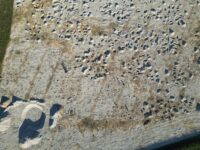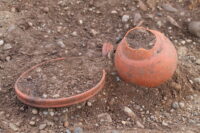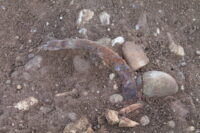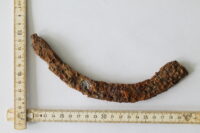 The remains of a large Celtic settlement of the La Tène people have been discovered in Lerchenauer Field, a northern suburb of Munich. About 2,300 years old, this is the first Celtic village ever found in Bavaria.
The remains of a large Celtic settlement of the La Tène people have been discovered in Lerchenauer Field, a northern suburb of Munich. About 2,300 years old, this is the first Celtic village ever found in Bavaria.
The site was excavated by the Bavarian State Office for Monument Preservation in advance of construction of a new housing development. Archaeologists discovered circular discolorations filled in with soil and gravel and identified them as post holes that would have once supported the roofs of Iron Age homes. The dwellings were varied in size and floor plan. Traces of wattle and daub indicate they were half-timbered wooden houses.
 Extrapolating from the number of post holes, archaeologists have concluded this was a settlement with more than 100 houses, a significantly higher number of dwellings than found in other Iron Age settlements. It would have been able to house a population of at least 500, making it something of an urban metropolis for that time and place. Archaeologists have long believed that the urban area of what is now Munich had numerous large villages in the Iron Age based on important individual finds from the period, but the Lerchenauer Field find is the first actual settlement to be discovered in Munich.
Extrapolating from the number of post holes, archaeologists have concluded this was a settlement with more than 100 houses, a significantly higher number of dwellings than found in other Iron Age settlements. It would have been able to house a population of at least 500, making it something of an urban metropolis for that time and place. Archaeologists have long believed that the urban area of what is now Munich had numerous large villages in the Iron Age based on important individual finds from the period, but the Lerchenauer Field find is the first actual settlement to be discovered in Munich.
 Two groups of graves were also found from different periods of occupation of the site first by Celts and then by Romans. One is from the late Iron Age (450 – 15 B.C.), and the other from the late Roman Imperial period (3rd-4th c. A.D.). Artifacts of note found in late Roman graves include a set of tableware — a plate, a jug with a handle and a drinking cup — made of soapstone, and a sickle blade. Sickles are very rarely discovered in graves.
Two groups of graves were also found from different periods of occupation of the site first by Celts and then by Romans. One is from the late Iron Age (450 – 15 B.C.), and the other from the late Roman Imperial period (3rd-4th c. A.D.). Artifacts of note found in late Roman graves include a set of tableware — a plate, a jug with a handle and a drinking cup — made of soapstone, and a sickle blade. Sickles are very rarely discovered in graves.
 The Roman graves were associated with a settlement that was built in the same area as the previous Celtic one. It was more modest in size and population than its predecessor. It was abandoned after the demise of the Western Roman Empire
The Roman graves were associated with a settlement that was built in the same area as the previous Celtic one. It was more modest in size and population than its predecessor. It was abandoned after the demise of the Western Roman Empire
Because of the importance of the finds, the developers are cooperating fully with the state archaeologists to expand the excavation. It will continue into 2024 to ensure that all archaeological remains are salvaged before construction begins.
* This article was originally published here












No comments:
Post a Comment